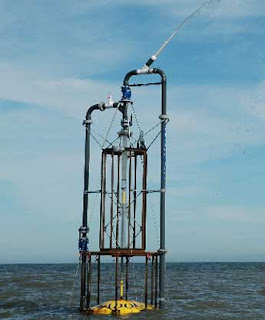Ocean Wave Technology Validated
 It is becoming increasingly clear that the oceans (and Great Lakes) are going to play a very important role in helping this nation achieve a sustainable energy future. Offshore wind has been receiving the lion's share of attention with respect to renewable energy technologies designed to take advantage of the marine environment, but wave-and-current-dependent technologies have also made significant advances of late.
It is becoming increasingly clear that the oceans (and Great Lakes) are going to play a very important role in helping this nation achieve a sustainable energy future. Offshore wind has been receiving the lion's share of attention with respect to renewable energy technologies designed to take advantage of the marine environment, but wave-and-current-dependent technologies have also made significant advances of late.A new ocean wave technology with potential for economically desalinating water. (GW)
Renewable Energy Ocean Wave Technology Validated
Texas A&M University's Report on Independent Natural Resources, Inc.'s SEADOG(R)Pump released
EarthTimes.com
May 20, 2008
Results of three-month
The report, which focused on a SEADOG Pump installed off the
"Most of the wave energy conversion devices developed to date experience one of many potential problems due to factors such as initial cost, operating cost, long rate of return, installation, and operational and maintenance issues mostly due to the highly-complex nature of structural and anchoring demands for the units. However, when considering the SEADOG Pump, which was conceptualized and developed by INRI(TM), most of the above mentioned potential problems are not present which can be credited to the simple design of the SEADOG Pump. This further implies that this device has the potential to become a good alternative energy conversion device that can be easily fabricated, deployed and maintained. Compared to other wave energy conversion devices developed to date, the SEADOG Pump has a good potential to become a functionally marketable machine in the near future," said
Dr. Warnakulasuriya also states in the report that the, "Overall effectiveness of the SEADOG Pump as a pump which converts ocean wave energy was around 22 percent and is a very promising value for a demonstration machine. The solid fact for this argument is that most of the highly-engineered and well-improved wave energy converters pretty much show similar values. The possibility of improving the SEADOG Pump to work at an overall effectiveness in the range of 45 to 55 percent is visible."
In the report, researchers praised the pump's design features for good mechanical efficiency that absorbs most of the potential energy and a significant amount of the kinetic energy content in the wave. This report further validates findings from a 21-day sea trial conducted in January of 2007 which compares the amount of energy SEADOG Pump can extract per square mile of deployment compared to other ocean, wind and solar renewable technologies. Because the pumps can be deployed in close proximity to each other, INRI(TM) estimates that they will produce five to 20 times more power per square mile than other technologies.
SEADOG Difference
Generally speaking, wave energy is captured by engineered devices or components attached to stationary or floating structures that are set in motion by waves or swells on the surface of the ocean. Most wave energy technologies grow in cost because the specified equipment is sensitive to corrosive seawater and has intermittency issues similar to wind and solar energy. SEADOG Pump on the other hand, separates itself from other technologies on the market by using a simple pump design with few moving parts and no electronics. Multiple pumps are deployed in fields depending on how much power or water is desired. In addition, the SEADOG Pump moves large volumes of water to shore where it can be stored until needed for energy production or desalination. This ability to store energy removes the intermittency issues associated with other renewable energy technologies.
"We're incredibly pleased with the report findings," said
Energy System Also Provides Desalination Remedy
The lack of sufficient fresh water is a growing concern in many regions of the world, and seawater desalination is increasingly essential;
How SEADOG Pump Works
Most wave-energy technologies involve off-shore electrical generation requiring the transmission of power to shore-based electrical grids. The SEADOG Pump captures energy from ocean swells or waves to pump seawater to land-based or sea-based holding areas, where the water can be returned to the ocean through turbines, thereby producing inexpensive, renewable electricity. Adding the ability to store the water and use it when needed will allow the SEADOG Pump to be a primary source of power that can match supply with demand. Other renewable energy technologies are considered to be secondary sources of power due to their intermittency issues. Preliminary estimates based on results from the sea trial suggest that a 1 square mile field of SEADOG Pumps could generate anywhere from 30 megawatts to more than 1,500 megawatts of electricity on average, depending on the wave regime. That electricity could power between 24,000 to more than 1.3 million U.S. households(1), while requiring no fossil fuel and emitting zero carbon dioxide or pollution into the atmosphere.
About Independent Natural Resources Inc.
Based in
EDITOR'S NOTE: To request a copy of the complete Texas A&M Report about the SEADOG Pump, send your e-mail request to seadog@inri.us.

0 Comments:
Post a Comment
<< Home